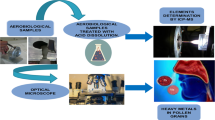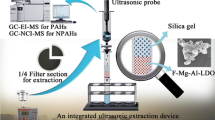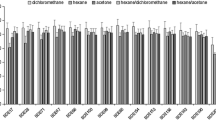Abstract
A rapid and simple method has been developed for determination of inorganic elements in airborne particulate matter (PM10) by using acidified subcritical water and ICP–OES. Elements such as Al, As, B, Ba, Cd, Cu, Fe, Mn, Pb, Se, and Zn were rapidly and efficiently extracted from PM10 samples with a solution of 0.1 mol L−1 HNO3 under subcritical conditions. The method requires approximately 5% of the amount of acid used in the standard microwave extraction procedure. The material selected for the subcritical extraction manifold was poly ether ether ketone (PEEK), to avoid sample contamination with elements present in previously reported stainless-steel manifolds. The extraction temperature, time of static and dynamic extraction, and flow rate of acidified water were studied keeping the pressure controlled at about 1,500 psig. The efficiency of extraction of most of the analytes increased with temperature, tending to quantitative extraction at temperatures near 150°C. After the extraction process the analytes were determined directly in the extract by ICP–OES. When the method was compared with the USEPA counterpart, the results indicate that under optimized conditions (static extraction time: 15 min, dynamic extraction time: 30 min, flow rate: 2 mL min−1) the analytes were extracted with recoveries between 73 and 158%. Alternatively, by using an extraction time of 15 min, the method could be used to screen for all the elements, with recoveries over 50%. The developed method was applied to the determination of inorganic elements in airborne particulate matter in the atmosphere of Santiago, Chile.


Similar content being viewed by others
References
Priego-López EP, Luque de Castro MD (2003) J Chromatogr A 1018:1–6
Luque-García JL, Luque de Castro MD (2003) J Chromatogr A 998:21–29
Kubátová A, Jansen B, Vaudoisot J, Hawthorne SB (2002) J Chromatogr A 975:175–188
David MD, Campbell S, Li QX (2000) Anal Chem 72:3665–3670
Hageman KJ, Mazeas L, Grabanski CB, Miller DJ, Hawthorne SB (1996) Anal Chem 68:3892–3898
Hawthorne SB, Trembley S, Moniot CL (2000) J Chromatogr A 886:237–244
Fernández-Pérez V, Jiménez-Carmona M, Luque de Castro MD (1999) J Anal At Spectrom 14:1761–1765
Richter P, Sienra R, Romero R (2002) Atmos Environ 36:2375–2381
Richter P, Sepúlveda B, Oliva R, Calderón K, Seguel R (2003) J Chromatogr A 994:169–177
Fernández-Pérez V, Jiménez-Carmona M, Cabanás-Espejo JM, Luque de Castro MD (1999) Anal Chim Acta 395:113–118
US-EPA (1999) Compendium of methods for the determination of inorganic compounds in ambient air. Method IO-3.1. Selection, preparation and extraction of filter material. Center for Environmental Research Information. Office of Research and Development
Dreetz CD, Lund W (1992) Anal Chim Acta 262:299–305
Hlavay J, Polyak K, Molnar A, Meszaros E (1998) Analyst 123:859–863
Hlavay J, Polyak K, Bodog I, Molnar A, Meszaros E (1996) Fresenius J Anal Chem 354:227–232
Lum KR, Betteridge JS, Macdonald RR (1982) Environ Technol Lett 3:57–62
Lum KR, Kokotich EA, Schroeder WH (1987) Sci Total Environ 63:161–173
Šlejkovec Z, Salma I, van Elteren JT, Zemplén-Papp É (2000) Anal Bioanal Chem, 366:830–834
Huggins FE, Panjala D, Pattanaik S, Huffman GP (2002) Fuel Chemistry Division Preprints 47(2):681–682
SESMA (Servicio de Salud Metropolitano del Ambiente) (2002) Caracterización de elementos inorgánicos presentes en el aire de la Región Metropolitana 1997–2000. Ministerio de Salud, Laboratorio de Salud Ambiental, Santiago de Chile, p 42
Artaxo P (1998) “Aerosol characterization study in Santiago-Chile wintertime 1998”. Report prepared for CONAMA RM, Santiago. http://www.conama.cl/rm/568/articles-2582_1998.pdf
Ulriksen P, Cabello A (1997) “Concentraciones de arsénico en material particulado atmosférico en Chile”, Proyecto FONDEF 2–24
Iniciativa de aire limpio en ciudades de América Latina. http://www.cleanairnet.org/lac/1471/article-40852.html
Acknowledgements
The authors thank FONDECYT for financial support (project No. 1030005). Thanks are also extended to CENMA and CEPEDEQ of the University of Chile for facilities given for carrying out the determinations by ICP–OES and ICP–MS, respectively.
Author information
Authors and Affiliations
Corresponding author
Rights and permissions
About this article
Cite this article
Morales-Riffo, J.J., Richter, P. Rapid determination of inorganic elements in airborne particulate matter by using acidified subcritical-water extraction and inductively-coupled plasma–optical-emission spectrometry. Anal Bioanal Chem 380, 129–134 (2004). https://doi.org/10.1007/s00216-004-2702-2
Received:
Revised:
Accepted:
Published:
Issue Date:
DOI: https://doi.org/10.1007/s00216-004-2702-2




